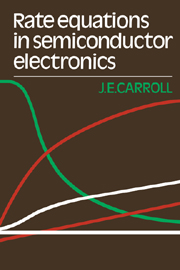Book contents
- Frontmatter
- Contents
- Preface
- 1 Introduction to rate equations
- 2 Elementary rate equations in semiconductors
- 3 Rates of switching
- 4 Rates of change and transfer in phase space
- 5 Rate equations in quantum electronics
- 6 Rate equations in optoelectronic devices
- 7 Advanced topics in rate equations
- Appendix A Counting states
- Appendix B Notes on differences between gas and diode laser rate equations
- Notes on solutions
- References
- Index
4 - Rates of change and transfer in phase space
Published online by Cambridge University Press: 04 December 2009
- Frontmatter
- Contents
- Preface
- 1 Introduction to rate equations
- 2 Elementary rate equations in semiconductors
- 3 Rates of switching
- 4 Rates of change and transfer in phase space
- 5 Rate equations in quantum electronics
- 6 Rate equations in optoelectronic devices
- 7 Advanced topics in rate equations
- Appendix A Counting states
- Appendix B Notes on differences between gas and diode laser rate equations
- Notes on solutions
- References
- Index
Summary
The Boltzmann equation
Introduction
The motion of charge carriers within a semiconductor (or a gas) can be found by a more formal approach through the Boltzmann collision equation, which provides an elegant method by considering the rates of change of particles within ‘phase’ space – a concept to be introduced shortly. To keep the discussion clear, a one-dimensional classical approach will be considered with charge carriers having an effective mass, m*, assumed to be independent of energy or direction (not strictly valid in a semiconductor but still a most useful simplification). Extensions to three dimensions and the required corrections for quantum theory can be dealt with in later reading.
The Boltzmann collision equation for the flow of many particles is a statistical equation on the conservation of particles in a six-dimensional space referred to as phase space. The six dimensions consist of the three space dimensions for x combined with the three additional dimensions for momentum p. Momentum is considered here as an independent variable with the same independence as position. It is the dynamical equations which link these six independent variables together. On first acquaintance, this concept of momentum and position being independent variables appears absurd because it is easy to confuse the dynamical link (given through an equation such as m dx/dt = p), with functional interdependence of p and x.
W. R. Hamilton in 1834 introduced the idea that all dynamical motion could be described in terms of a function H(p, x, t) = 0 linking the momentum p and position x in time. Coordinates of position and momentum can be defined and are treated as of equal independence. […]
- Type
- Chapter
- Information
- Rate Equations in Semiconductor Electronics , pp. 60 - 82Publisher: Cambridge University PressPrint publication year: 1986

